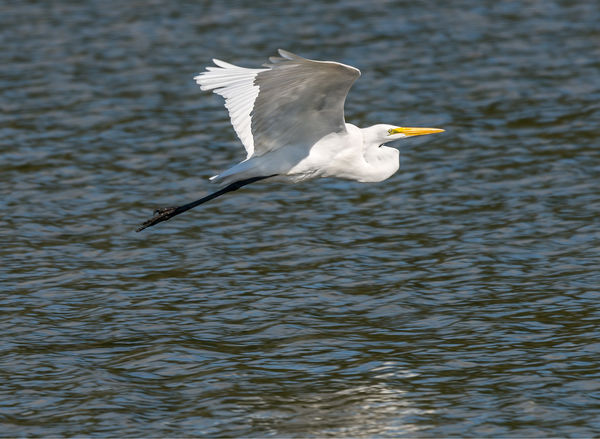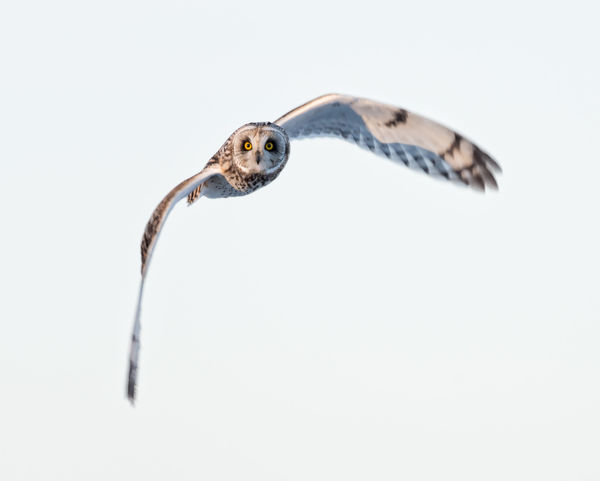Bird photography
Feb 13, 2018 13:47:32 #
How do I setup my camera to take a good shot of a bird in flight against a bright sky in the background? My camera has no auto ISO. How do I determine the best combination of A, S, and ISO; using AF-C and burst mode? I am an amateur, so professional friends, please share your experience. Thanks
Feb 13, 2018 13:58:45 #
noeT wrote:
How do I setup my camera to take a good shot of a bird in flight against a bright sky in the background? My camera has no auto ISO. How do I determine the best combination of A, S, and ISO; using AF-C and burst mode? I am an amateur, so professional friends, please share your experience. Thanks
What gear are you using?
How close do you think you can get to the bird?
How are your post processing skills?
Feb 13, 2018 14:04:21 #
noeT wrote:
How do I setup my camera to take a good shot of a bird in flight against a bright sky in the background? My camera has no auto ISO. How do I determine the best combination of A, S, and ISO; using AF-C and burst mode? I am an amateur, so professional friends, please share your experience. Thanks
You do not need auto ISO, or auto anything for shooting birds in flight. You set your ISO as always, according to the wheather and regarding potential noise, but want to be open to the idea of upping the ISO by quite a bit to allow for a fast enough shutter speed. Aperture, again is set as usually for enough depth of filed, you don't want to go too large, as that will make focusing much more of a challenge. Just go out there, practice and find the settings that suit you the best and most important of all, go out there and have fun!
Feb 13, 2018 14:45:41 #
There is another current topic with similar question:
http://www.uglyhedgehog.com/t-513652-1.html
I wrote a bit there, including suggesting that the OP check in with the UHH specialty forum on birds in flight. Lots of great stuff and experienced photographers there. Home page:
http://www.uglyhedgehog.com/s-112-1.html
There is no one-size fits all: shooting dark-colored birds against light skies is very different from shooting light-colored birds against those same bright/light skies. Even shutter speeds may need to vary, depending on the quickness of your bird
You might want to read a few articles or watch videos on setting exposure compensation and understanding how a camera meters a scene. A good foundation of knowledge will help you with many situations.
http://www.uglyhedgehog.com/t-513652-1.html
I wrote a bit there, including suggesting that the OP check in with the UHH specialty forum on birds in flight. Lots of great stuff and experienced photographers there. Home page:
http://www.uglyhedgehog.com/s-112-1.html
There is no one-size fits all: shooting dark-colored birds against light skies is very different from shooting light-colored birds against those same bright/light skies. Even shutter speeds may need to vary, depending on the quickness of your bird

You might want to read a few articles or watch videos on setting exposure compensation and understanding how a camera meters a scene. A good foundation of knowledge will help you with many situations.
Feb 13, 2018 15:25:49 #
I can use a Nikon d500 or D800 with Nikon dx 18-300mm. The lens is not too sharp at 300. I am thinking of getting the Nikon 200-500.
Feb 13, 2018 16:33:49 #
Feb 13, 2018 16:52:16 #
noeT wrote:
I can use a Nikon d500 or D800 with Nikon dx 18-300mm. The lens is not too sharp at 300. I am thinking of getting the Nikon 200-500.
The D800 and a Tamron 150-600 G2 would be a stunningly good combination. I would pass on the D500, which is not as good at high ISO and does not record as much detail. I suggest you start with birds on perches or larger, slower moving birds, until you get your exposure settings down.
I often shoot eagles in the winter, which present a difficult lighting scenario - bird with bright white head and tail, and very dark plumage everywhere else. I use the camera's light meter in spot mode to read the head, tail, or even nearby snow or ice, as long as it is getting the same light as the bird. I then set my camera to manual mode, add 1-1/3 stops to the reading, stop my lens down to F7.1 and adjust my shutter to 1/800. The ISO is then determined by the other settings and the light. I find that in good light the ISO can range from 100 - 400. But when the light gets dicey, it is not unusual to use ISO 800 or higher.
The first shot was on a tripod with a D800, 600mmF4 at F5.6, 1/800.
The second was a D800, Sigma Sport 150-600 at F7.1 ISO 100, 1/800, hand held.
The last was a D800, Sigma Sport, F7.1, ISO 800, 1/500, D800, hand held.
Feb 13, 2018 22:30:31 #
Thanks. I’ll check out the Sigma. If there’s one available for rent at our local camera store, I’ll rent it and see how it feels hand held. Do you have any experience with the new Tamron 150-600. I tried it at the store. The shots were sharp using the D500 hand held. I think it is lighter than the Sigma sport and cheaper. Have you tried using a teleconverter with your D800 and Sigma lens?
Feb 13, 2018 22:31:59 #
Feb 13, 2018 22:34:11 #
Feb 14, 2018 05:49:16 #
noeT wrote:
Thanks. I’ll check out the Sigma. If there’s one available for rent at our local camera store, I’ll rent it and see how it feels hand held. Do you have any experience with the new Tamron 150-600. I tried it at the store. The shots were sharp using the D500 hand held. I think it is lighter than the Sigma sport and cheaper. Have you tried using a teleconverter with your D800 and Sigma lens?
I am not sure who you are responding to, so I'll take a guess it's me. You might be able to save some $$$ and just read the reviews of all of these lenses here:
https://photographylife.com/shooting-hand-held-with-the-sigma-150-600mm-sport
https://photographylife.com/reviews/nikon-200-500mm-f5-6e-vr
https://photographylife.com/reviews/tamron-sp-150-600mm-f5-6-3-g2
I've shot a couple of days with the Tamron G2 and found it to be as sharp, if not sharper, than my Sigma Sport, and it is almost 2 lb lighter and $600 cheaper.
I borrowed the 200-500 for two weeks under the NPS program, and found it to be also quite good, but lacked the reach of a 600mm lens, and was just OK with a 1.4 TC. It lacked the build quality of the other two, and does not have good dust and moisture sealing. It's a very good lens, but don't buy it expecting to use it with a 1.4 TC.
In fact, don't buy any of these lenses expecting to use it with a TC - you'll lose one stop of light, making the Sigma and Tamron F9 max aperture lenses, and the Nikon F8, and you will end up with a lens that MUST be on a tripod, because it is nearly impossible to get consistently good results handholding a 700mm or 840mm lens. That tripod you'll need to get will set you back what the Nikon or Tamron lens costs, btw.
Feb 14, 2018 05:50:03 #
noeT wrote:
How does the Tamron compare to the Sigma sport?
Equivalent -
https://photographylife.com/reviews/tamron-sp-150-600mm-f5-6-3-g2
Feb 14, 2018 08:48:30 #
ToBoldlyGo
Loc: London U.K.
If you will be cropping, the D500 will give you a little more detail on the bird than the D800. Though the actual difference may well be marginal. Just something to factor in.
Feb 14, 2018 08:52:55 #
noeT wrote:
How do I setup my camera to take a good shot of a bird in flight against a bright sky in the background? My camera has no auto ISO. How do I determine the best combination of A, S, and ISO; using AF-C and burst mode? I am an amateur, so professional friends, please share your experience. Thanks
You might want to post this in the Birds-In-Flight / Birds-On-Water Forum here on UHH:
http://www.uglyhedgehog.com/s-112-1.html
Feb 14, 2018 09:17:42 #
noeT wrote:
How do I setup my camera to take a good shot of a bird in flight against a bright sky in the background? My camera has no auto ISO. How do I determine the best combination of A, S, and ISO; using AF-C and burst mode? I am an amateur, so professional friends, please share your experience. Thanks
For other than mostly black or mostly white birds, 1/1600 ss, f5.6, ISO 400 (auto ISO if possible) - conditions, sky - blue to semiblue ....sun - full bright to semi-veiled bright. If the sky gets lighter or the sun gets darker, you will have to give more exposure somewhere- preferably ISO and preferably with exposure metering compensation ( if you have a late model camera/sensor). Also, some consideration must be given as to how much white or dark feather detail is desired in the final image and exposure moved.
If you want to reply, then register here. Registration is free and your account is created instantly, so you can post right away.






